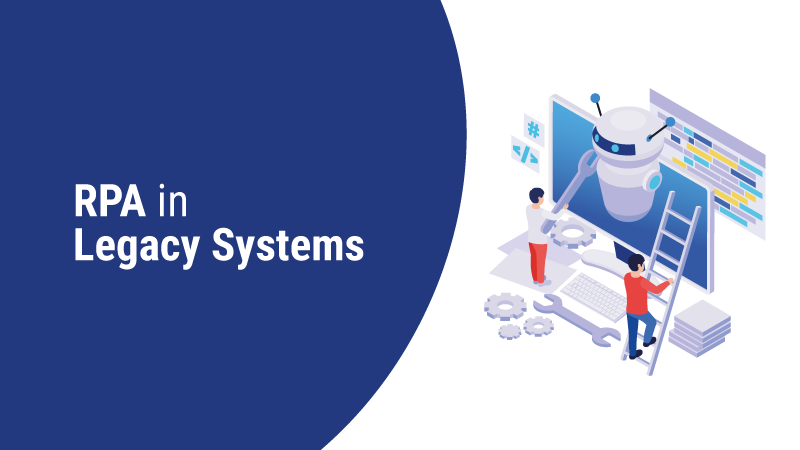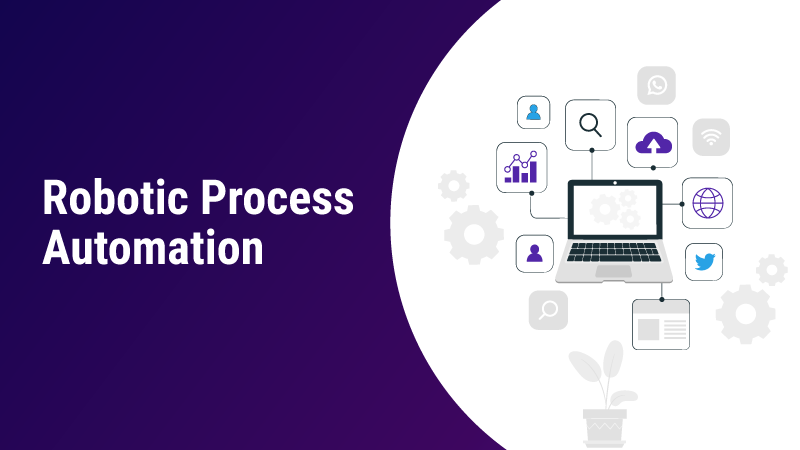Why Use RPA in Legacy Systems?

Robotic Process Automation (RPA) has always been serving its role as a promising solution for many enterprises that are about to commence a digital transformation journey. With constantly evolving requirements and demands of consumers and companies, businesses are in need of taking advantage of the power of modern technology. However, legacy systems are often seen as a major barrier to attaining competitive advantages.
Legacy systems use obsolete technology, applications, and hardware that use conventional or outdated software. Choosing modern and advanced technologies over the old and obsolete ones is theoretically an excellent idea, but not so easy to bring into practice. Many IT companies still use legacy systems to a specific extent, but they face many problems like security issues and incompatibility. Moreover, legacy systems cannot be integrated with any new process because of the following reasons:
- Lack of proper IT support
- Complications during the integration
- Difficulty in maintenance
- Poor user experience
This is where RPA works by enabling businesses to effortlessly convert legacy systems upgrade solutions. RPA mainly aims to automate monotonous and manual tasks, that are rule-based and take up a lot of time and resources of an organization.
Benefits of deploying RPA in legacy systems
The advantages of Robotic Process Automation (RPA) are appealing to businesses seeking to make efficient workflows, boost efficiency, and increase output. Anyhow, there are a lot of organizations who are not sure whether it is a good option to upgrade their legacy systems or use automated tools such as RPA to keep up their competitive margin. The fact is that the RPA helps companies to get better business results by integrating with their legacy systems. Here are some of the major benefits of implementing RPA in legacy systems:
Automation of business processes
A company has many functional tasks across different departments that can be automated to create more dynamism. RPA can automate rule-based and standardized tasks that are structured and repetitive. Automation using RPA solution includes error reconciliation, data entry processes, invoice processing, and small decision-making tasks. Hence, it is important to recognize the business processes that can take advantage of RPA, before deploying RPA bots into legacy systems.
Integrate different workflows
RPA software bots are capable of performing business tasks with a greater speed and with fewer errors than manual processing. It enables businesses to integrate workflows throughout different departments and legacy platforms to increase dynamism and take advantage of its speed and precision. Obsolete systems like customer relationship management, finance systems, email, etc. can be leveraged with RPA tools to make monotonous tasks of multiplatform data entry and processing easier and simpler.
Low expenses
Unlike the systems that run on APIs, RPA deployment does not demand the requirement of highly professional employees once it is deployed. This helps to reduce the cost incurred for deployment while providing businesses with a scalable solution to suit various operational requirements as needed.
Improved future readiness
It is evident that RPA enables enterprises to obtain more mileage from their existing systems. That is, if there is any need to upgrade your legacy software or bring up a new system without an inbuilt integration option, automation can easily handle the process. It is easy for digital workers to process and transfer data quickly from existing systems to the latest ones rather than depending on manual techniques alone.
Low-security issues
One of the major benefits RPA offers is improved security. When compared to the threats possessed by other alternatives, integration of legacy systems using RPA involves zero or minimal risk of data leakage or other security concerns. RPA enables enterprises to completely restrict their access authentication and securely manage strategic information.
Reduced Employee Workloads
One of the most important benefits of RPA is that the most trivial and tedious jobs will be handed over to RPA’s digital workers. They mimic the manual steps that employees do in their legacy systems and are much faster and more precise. Meanwhile, employees can give attention to meaningful tasks that harmonize well with their skills and give better value to the organization.
Why use RPA to improve legacy systems?
When it comes to the up-gradation of legacy systems, there is no better technological tool that is cheaper, scalable, and faster than robotic process automation. Other than that, most mainframe legacy applications are not compatible enough to be integrated through APIs. This is where RPA takes the lead in improving such legacy systems.
Legacy software is vulnerable to security breaches over time because the previous versions are no more supported. The significance of upgrading legacy systems using RPA is not only related to the smooth functioning of the system but also associated with the security of the system. The security is high and more sophisticated in the RPA technology and therefore prevents any risk of system hack by an external party. Additionally, RPA bots facilitate the transfer of data from legacy systems to external or local sources like google spreadsheets, cloud storage, and any other available options.
Wrap Up
Finally, Robotic Process Automation improves the performance and functional life of legacy software and enables organizations to eliminate expensive upgrades, training costs, and the division of strictly integrated workflows. Integrating legacy systems with RPA is important as well as easy. The application of robotic process automation can be effectively integrated with CRM, SAP, Excel, and many more. This way, mechanical work involving human laborers working on legacy systems can be eliminated. Furthermore, it is important for a business to identify the most appropriate usage cases accurately, select the right RPA vendor, calculate the ROI, and plan its RPA-based legacy upgrade process accordingly.
Get Started with our RPA Services
Blogs by Category
AppForms Artificial Intelligence Blockchain Call Centers Chatbots Cloud Computing Data Management Design Digital Marketing Digital Transformation Enterprise Applications FinTech Insights LowCode Development Microsoft Mobile Apps News Office 365 Robotic Process Automation Security SharePoint Software Development Web ApplicationWhat is Robotic Process Automation? RPA Explained

2024-05-23 16:56:57